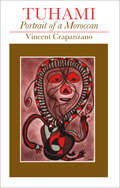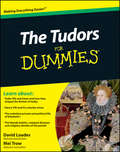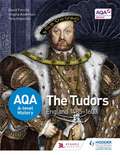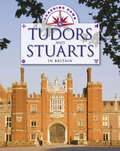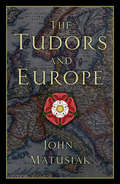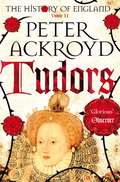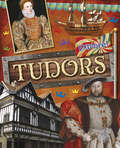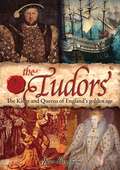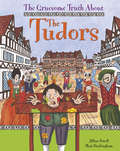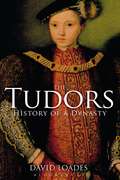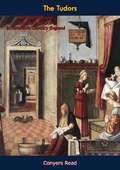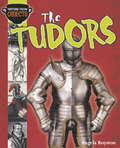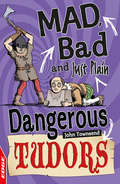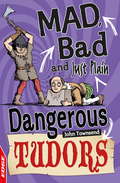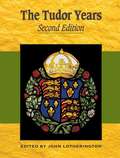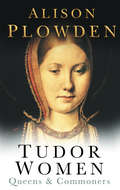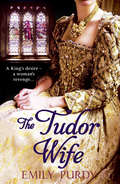- Table View
- List View
Tuhami: Portrait of a Moroccan
by Vincent CrapanzanoTuhami is an illiterate Moroccan tilemaker who believes himself married to a camel-footed she-demon. A master of magic and a superb story-teller, Tuhami lives in a dank, windowless hovel near the kiln where he works. Nightly he suffers visitations from the demons and saints who haunt his life, and he seeks, with crippling ambivalence, liberation from 'A'isha Qandisha, the she-demon. In a sensitive and bold experiment in interpretive ethnography, Crapanzano presents Tuhami's bizarre account of himself and his world. In so doing, Crapanzano draws on phenomenology, psychoanalysis, and symbolism to reflect upon the nature of reality and truth and to probe the limits of anthropology itself. Tuhami has become one of the most important and widely cited representatives of a new understanding of the whole discipline of anthropology.
Tuhami: Portrait of a Moroccan
by Vincent CrapanzanoTuhami is an illiterate Moroccan tilemaker who believes himself married to a camel-footed she-demon. A master of magic and a superb story-teller, Tuhami lives in a dank, windowless hovel near the kiln where he works. Nightly he suffers visitations from the demons and saints who haunt his life, and he seeks, with crippling ambivalence, liberation from 'A'isha Qandisha, the she-demon. In a sensitive and bold experiment in interpretive ethnography, Crapanzano presents Tuhami's bizarre account of himself and his world. In so doing, Crapanzano draws on phenomenology, psychoanalysis, and symbolism to reflect upon the nature of reality and truth and to probe the limits of anthropology itself. Tuhami has become one of the most important and widely cited representatives of a new understanding of the whole discipline of anthropology.
Tuhami: Portrait of a Moroccan
by Vincent CrapanzanoTuhami is an illiterate Moroccan tilemaker who believes himself married to a camel-footed she-demon. A master of magic and a superb story-teller, Tuhami lives in a dank, windowless hovel near the kiln where he works. Nightly he suffers visitations from the demons and saints who haunt his life, and he seeks, with crippling ambivalence, liberation from 'A'isha Qandisha, the she-demon. In a sensitive and bold experiment in interpretive ethnography, Crapanzano presents Tuhami's bizarre account of himself and his world. In so doing, Crapanzano draws on phenomenology, psychoanalysis, and symbolism to reflect upon the nature of reality and truth and to probe the limits of anthropology itself. Tuhami has become one of the most important and widely cited representatives of a new understanding of the whole discipline of anthropology.
Tuhami: Portrait of a Moroccan
by Vincent CrapanzanoTuhami is an illiterate Moroccan tilemaker who believes himself married to a camel-footed she-demon. A master of magic and a superb story-teller, Tuhami lives in a dank, windowless hovel near the kiln where he works. Nightly he suffers visitations from the demons and saints who haunt his life, and he seeks, with crippling ambivalence, liberation from 'A'isha Qandisha, the she-demon. In a sensitive and bold experiment in interpretive ethnography, Crapanzano presents Tuhami's bizarre account of himself and his world. In so doing, Crapanzano draws on phenomenology, psychoanalysis, and symbolism to reflect upon the nature of reality and truth and to probe the limits of anthropology itself. Tuhami has become one of the most important and widely cited representatives of a new understanding of the whole discipline of anthropology.
The Tudors For Dummies
by David Loades Mei TrowThis entertaining guide covers the period from 1485 to 1603, exploring the life and times of everyday people (from famine and the flu epidemic, to education, witchcraft and William Shakespeare) as well as the intrigues and scandals at court. Strap yourself in and get ready for a rollercoaster ride through the romantic and political liaisons of Henry VIII and Elizabeth I - and that's not all! Information on surviving Tudor buildings, such as Hampton Court, adds a contemporary twist for readers wanting to bring history to life by visiting these historic sites. The Tudors For Dummies includes: Part I: The Early Tudors Chapter 1: Getting to Know the Tudors Chapter 2: Surveying the Mess the Tudors Inherited Chapter 3: Cosying Up With the First Tudor Part II: Henry VIII Chapter 4: What was Henry like? Chapter 5: How Henry Ran his Kingdom Chapter 6: Divorced, Beheaded, Died; Divorced, Beheaded, Survived: The Perils of Marrying Henry Chapter 7: Establishing a New Church: Henry and Religion Part III: Edward VI, Mary and Philip, and Queen Mary Chapter 8: Edward, the Child King Chapter 9: Establishing Protestantism Chapter 10: Northumberland, Lady Jane Grey and the Rise of Mary Chapter 11: What Mary Did Chapter 12: Weighing Up War and Disillusionment Part IV: The First Elizabeth Chapter 13: The Queen and her Team Chapter 14: Breaking Dinner Party Rules: Discussing Religion and Politics Chapter 15: Tackling Battles, Plots and Revolts Chapter 16: Making War with Spain Chapter 17: Understanding the Trouble in Ireland Chapter 18: Passing on the Baton - Moving from Tudors to Stewarts Part V: The Part of Tens Chapter 19: Ten top Tudor Dates Chapter 20: Ten Things the Tudors Did For Us Chapter 21: Ten (Mostly) Surviving Tudor Buildings
The Tudors For Dummies
by David Loades Mei TrowThis entertaining guide covers the period from 1485 to 1603, exploring the life and times of everyday people (from famine and the flu epidemic, to education, witchcraft and William Shakespeare) as well as the intrigues and scandals at court. Strap yourself in and get ready for a rollercoaster ride through the romantic and political liaisons of Henry VIII and Elizabeth I - and that's not all! Information on surviving Tudor buildings, such as Hampton Court, adds a contemporary twist for readers wanting to bring history to life by visiting these historic sites. The Tudors For Dummies includes: Part I: The Early Tudors Chapter 1: Getting to Know the Tudors Chapter 2: Surveying the Mess the Tudors Inherited Chapter 3: Cosying Up With the First Tudor Part II: Henry VIII Chapter 4: What was Henry like? Chapter 5: How Henry Ran his Kingdom Chapter 6: Divorced, Beheaded, Died; Divorced, Beheaded, Survived: The Perils of Marrying Henry Chapter 7: Establishing a New Church: Henry and Religion Part III: Edward VI, Mary and Philip, and Queen Mary Chapter 8: Edward, the Child King Chapter 9: Establishing Protestantism Chapter 10: Northumberland, Lady Jane Grey and the Rise of Mary Chapter 11: What Mary Did Chapter 12: Weighing Up War and Disillusionment Part IV: The First Elizabeth Chapter 13: The Queen and her Team Chapter 14: Breaking Dinner Party Rules: Discussing Religion and Politics Chapter 15: Tackling Battles, Plots and Revolts Chapter 16: Making War with Spain Chapter 17: Understanding the Trouble in Ireland Chapter 18: Passing on the Baton - Moving from Tudors to Stewarts Part V: The Part of Tens Chapter 19: Ten top Tudor Dates Chapter 20: Ten Things the Tudors Did For Us Chapter 21: Ten (Mostly) Surviving Tudor Buildings
The Tudors England, 1485-1603 - AQA A Level History (PDF)
by David Ferriby Angela Anderson Tony ImperatoAQA approved Enhance and expand your students' knowledge and understanding of their AQA breadth study through expert narrative, progressive skills development and bespoke essays from leading historians on key debates. - Builds students' understanding of the events and issues of the period with authoritative, well-researched narrative that covers the specification content - Introduces the key concepts of change, continuity, cause and consequence, encouraging students to make comparisons across time as they advance through the course - Improves students' skills in tackling interpretation questions and essay writing by providing clear guidance and practice activities - Boosts students' interpretative skills and interest in history through extended reading opportunities consisting of specially commissioned essays from practising historians on relevant debates - Cements understanding of the broad issues underpinning the period with overviews of the key questions, end-of-chapter summaries and diagrams that double up as handy revision aids The Tudors: England 1485-1603 A revised edition of Access to History: An Introduction to Tudor England 1485-1603, this title explores the consolidation of the Tudor Dynasty under Henry VII and Henry VIII, the years of instability and religious turmoil in the mid-Tudor period and the period of relative stability during Elizabeth I's reign. It considers breadth issues of change, continuity, cause and consequence in this period through examining key questions on themes such as power, religion, opposition, relations with foreign powers and the impact of key individuals.
The Tudors and Stuarts in Britain: The Tudors And Stuarts In Britain (Tracking Down #33)
by Moira Butterfield'The past is all around us, if we know where to look.' This series takes a look at archaeological, structural and museum evidence from around Britain, allowing readers to build up a picture of what life was like in key historical periods and how you can discover it for yourself by visiting sites around the country.
The Tudors and Europe
by John MatusiakIn 1517, a certain Dr Beale, rector of St Mary Spitall in London, had roused the capital’s mob by laying the blame for an increase in poverty squarely upon the shoulders of grasping foreigners. ‘God has given England to Englishmen,’ he fumed, and ‘as birds would defend their nest, so ought Englishmen to cherish and defend themselves and to hurt and grieve aliens for the common weal.’ But migration was not the only factor influencing Tudor attitudes to Europe. War, religion, commerce and dynastic security were all critical in linking England to developments abroad, and in ways that remain strikingly relevant today. What were the forces that shaped the shifting perspectives of Tudor men and women and their rulers towards a continent at the crossroads? And what, in turn, were the responses of sixteenth-century Europeans to their counterparts across the Channel? The Tudors and Europe looks at a time when the very survival of England hung critically in the balance and asks if it has lessons for the present.
Tudors: The History of England Volume II (The History of England #2)
by Peter AckroydFollowing on from Foundation, Tudors is the second volume in Peter Ackroyd's astonishing series, The History of England.Rich in detail and atmosphere and told in vivid prose, Tudors recounts the transformation of England from a settled Catholic country to a Protestant superpower. It is the story of Henry VIII's cataclysmic break with Rome, and his relentless pursuit of both the perfect wife and the perfect heir; of how the brief reign of the teenage king, Edward VI, gave way to the violent reimposition of Catholicism and the stench of bonfires under 'Bloody Mary'. It tells, too, of the long reign of Elizabeth I, which, though marked by civil strife, plots against the queen and even an invasion force, finally brought stability.Above all, however, it is the story of the English Reformation and the making of the Anglican Church. At the beginning of the sixteenth century, England was still largely feudal and looked to Rome for direction; at its end, it was a country where good governance was the duty of the state, not the church, and where men and women began to look to themselves for answers rather than to those who ruled them.
Tudors: Tudors (Explore! #10)
by Jane BinghamThis photographic book gives you an overview of the reign of the Tudors. From how their reign began to the famous monarchs that continued it, Henry VIII, Mary I and Elizabeth I. You can find out about the many wives of Henry VIII, the power of Elizabeth I, what the Tudors did for entertainment, what their houses were like and the advancements they made in exploration, art and science. You can read about the daily life of a Tudor kitchen maid, and even make your own Tudor gingerbread.
The Tudors: The Kings and Queens of England's Golden Age
by Jane BinghamThe Tudor dynasty presided over one of the most dynamic periods in English history, an era that witnessed courtly conspiracies and public executions, religious reformation and exploration. Its fearsome monarchs transformed England from a minor medieval kingdom into a major player on the world stage.The Tudors reveals the complex personalities behind this powerful family, and the passions and jealousies that spurred them on. From the penny-pinching Henry VII to his profligate, wife-hungry son Henry VIII, and from the religious persecutions of Mary I to the 'golden age' of her sister Elizabeth I, this is a gripping, entertaining romp through a fascinating age.
The Tudors: The Kings and Queens of England's Golden Age
by Jane BinghamThe Tudors were an unforgettable dynasty who wielded absolute power during a remarkably turbulent time in English history. Each ruler's survival required a fierce struggle to maintain control - often against incredible odds.From Henry VII, England's last king to win the crown in battle, and the tyrannical Henry VIII with his succession of wives, to the fiercely Catholic 'Bloody Mary', and her sister, Elizabeth, the 'Virgin queen', Jane Bingham examines just how fairly history has treated these Tudor rulers.Both as politicians and as individuals, it is no wonder these larger-than-life monarchs still capture our imaginations today.
The Tudors: Tudors (The Gruesome Truth About #14)
by Matt BuckinghamCovering different historical eras, this informative series details all the topics one would expect to find in a history series, such as family life, food, religion, entertainment and warfare. However, it focuses on the most gruesome parts of these topics.
The Tudors: History of a Dynasty
by David LoadesDavid Loades provides a masterful overview of this formative period of British history. Exploring the reign of each monarch within the framework of the dynasty, he unpacks the key questions surrounding the monarchy; the relationship between church and the state, development of government, war and foreign policy, the question of Ireland and the issue of succession in Tudor politics. Loades considers the recent scholarship on the dynasty as a whole, paying particular attention to Henry VIII, Elizabeth I and Mary Tudor. He also considers how recent revisionist history asks new questions of their political and personal lives. This places our understanding of the dynasty as a whole in a new light.
The Tudors: History of a Dynasty
by David LoadesDavid Loades provides a masterful overview of this formative period of British history. Exploring the reign of each monarch within the framework of the dynasty, he unpacks the key questions surrounding the monarchy; the relationship between church and the state, development of government, war and foreign policy, the question of Ireland and the issue of succession in Tudor politics. Loades considers the recent scholarship on the dynasty as a whole, paying particular attention to Henry VIII, Elizabeth I and Mary Tudor. He also considers how recent revisionist history asks new questions of their political and personal lives. This places our understanding of the dynasty as a whole in a new light.
The Tudors: Personalities and Practical Politics in Sixteenth Century England
by Conyers ReadFirst published in 1936, author Conyers Read’s The Tudors provides a brief survey of the history of England under the Tudors during the sixteenth century. It will appeal to students of courses in English history or English literature and general history buffs alike.Beautifully illustrated with black & white portraits.
The Tudors: Tudors (History from Objects #1)
by Angela RoystonThrough examining primary evidence, such as, pots, swords, remains, artwork, buildings and tapestries, the reader will be introduced to each historical age.
Tudors (EDGE: Mad, Bad and Just Plain Dangerous #2)
by John TownsendTime to take a sideways look at the bizarre and outrageous from throughout history - and it's all TRUE!Which mad cure involved swallowing live frogs?Which bad ruler had the most heads chopped off at the Tower of London?Which Tudor invention do we still use today to get rid of dangerous waste?Find out the answers to these questions inside, along with lots of facts, quizzes, and other bonkers stuff as you take a bumpy journey into the darkest crannies of Tudor history with Mad, Bad and Just Plain Dangerous!
Tudors (EDGE: Mad, Bad and Just Plain Dangerous)
by John TownsendTime to take a sideways look at the bizarre and outrageous from throughout history - and it's all TRUE!Which mad cure involved swallowing live frogs?Which bad ruler had the most heads chopped off at the Tower of London?Which Tudor invention do we still use today to get rid of dangerous waste?Find out the answers to these questions inside, along with lots of facts, quizzes, and other bonkers stuff as you take a bumpy journey into the darkest crannies of Tudor history with Mad, Bad and Just Plain Dangerous!
The Tudor Years (PDF)
by John Lotherington David Grossel Henry Jeffries Malcolm Saxon Peter Servini Roy Sloan Edward TowneThe second / 2nd edition of this popular Years of. . . title provides core coverage of English history from the emergence of the Tudor dynasty during the Wars of the Roses through to the death of Elizabeth I. The authors analyse the reigns of the respective Tudor monarchs and examine important themes including the Tudor Rebellions, economy and society, culture and society, religion in Tudor England, and relations with Scotland, Wales and Ireland during the period. The chapters are detailed yet accessible, and feature up-to-date and stimulating selections of visual and written source material.
Tudor Women: Queens & Commoners
by Alison PlowdenThe Tudor era belongs to its women. No other period of English history has produced so many notable and interesting women, and into other periods have they so powerfully influenced the course of political events. Mary Tudor, Elizabeth I and, at moments of high drama, Mary Queen of Scots dominated the political scene for more than half a century, while in the previous fifty years Henry VIII's marital escapades brought six more women to the centre of attention. In this book the women of the royal family are the central characters; the royal women set the style and between them they provide a dazzling variety of personalities as well as illustrating almost every aspect of life as it affected women in Tudor England. We know what they ate, how they dressed, the books they read and the letters they wrote. Even the greatest of them suffered the universal legal and physiological disabilities of womanhood - some survived them, some went under. Now revised and updated, Alison Plowden's beautifully written account of the women behind the scenes and at the forefront of sixteenth-century English history will be welcomed by anyone interested in exploring this popular period of history from the point of view of the women who made it.
The Tudor Wife
by Emily PurdyA lustful king. A thirst for power. The terrible price of revenge… Encompassing the reigns of four of Henry's wives, from the doomed Anne to the reckless Katherine Howard, The Tudor Wife is an unforgettable story of ambition, lust, and jealousy.
Tudor weapons (UEB Uncontracted)
This image shows three weapons from the Tudor period: a sword, a dagger and a cannon. There is a locator dot shown, which will be at the top left of the page when the image is the right way up. The sword is at the left of the page, with its hilt (handle) at the top and the tip of its long blade at the bottom. To the left of the hilt there is the curved knuckle guard, and just below this the cross guard; these protected the sword hand from blows by an opponent. To the right of the sword at the top of the page is a dagger with its handle at the top, the cross guard part way down, and the short, sharp blade at the bottom. Across the bottom of the page is a cannon seen from the side. The long barrel of the cannon rests on a two-wheeled gun carriage (although only one wheel is visible), with its muzzle at the right of the page. Below this, at the bottom right corner of the page, there is a pile of six cannon balls. Just to the left of these, one of the large wheels of the gun carriage can be found.
Tudor weapons (UEB Contracted)
This image shows three weapons from the Tudor period: a sword, a dagger and a cannon. There is a locator dot shown, which will be at the top left of the page when the image is the right way up. The sword is at the left of the page, with its hilt (handle) at the top and the tip of its long blade at the bottom. To the left of the hilt there is the curved knuckle guard, and just below this the cross guard; these protected the sword hand from blows by an opponent. To the right of the sword at the top of the page is a dagger with its handle at the top, the cross guard part way down, and the short, sharp blade at the bottom. Across the bottom of the page is a cannon seen from the side. The long barrel of the cannon rests on a two-wheeled gun carriage (although only one wheel is visible), with its muzzle at the right of the page. Below this, at the bottom right corner of the page, there is a pile of six cannon balls. Just to the left of these, one of the large wheels of the gun carriage can be found.
